Your Home Renovation Planning Guide
Are you about to embark on a home renovation project, but aren’t quite sure where to start? To stick to your budget, following a structure is crucial.
In just one year, one in three Australians undertook a home renovation, with an average spend of $26,000 per project. Given the state of Australia’s red hot property market, it’s no surprise that many of us opted to upgrade our existing properties instead of packing up and moving onto the next one.
Even if you have no intention of selling your home anytime soon, undertaking a home renovation has the potential to add real value to your abode. While undertaking a home renovation is not necessarily the right path for everyone, if you have the time, funds and flexibility to do so, the potential payoffs can be lucrative – but how do you get it right?
Six Key Steps For Planning A Home Renovation
Renovating any home – no matter how big or small – requires a serious amount of attention to detail. However, if you set yourself up properly with a clear plan in mind and pick an ideal time to renovate, it can go a long way when it comes to minimising stress and potential budget blowouts.
The golden rule with most home renovation projects is to avoid overcapitalisation. If you have spent $200,000 on renos, but only made a $100,000 profit in the event of a potential sale, then your home renovation will have effectively cost you money instead of making it. Instead, experts indicate that you should allow 10% of your property value for your renovation budgets.
Apart from some in-depth budgeting linked to the house renovation cost, the key steps to planning a successful home renovation will generally include the following –
Have A Vision – Before you start shopping, have a clear vision for your home renovation – are you looking for more space, or to improve its overall value? In addition, a physical mood board allows you to touch, feel and rearrange your choices in order to help execute decisions on what types of inclusions you would like to see in your home’s new interior design.
Check If You Need Permits – Depending on the nature of your reno, you may be required to get a planning permit from your local council, followed by a building permit. Failure to do so can result in hefty fines and can even result in any work done being demolished, so be sure to do your homework first. If you’re unsure, this handy guide can be used as a quick reference.
Decide On Your Layout – Particularly relevant for the kitchen and bathroom, changing the layout of the area in question can see costs quickly skyrocket. This is because a new layout means new connection points for electricity and moving things around for the plumbing. While these are two of the more expensive trades, thankfully they’re entirely avoidable.
Sort Out Your Finance – The average home renovation spend in Australia is currently sitting at $26,000 per project. If that’s not the kind of cash that you readily have lying around, then a trip to the bank or your local broker should be given priority before you even think about proceeding any further. It’s also a good idea to keep a thorough paper trail when paying for labour work.
Enlist The Tradies – While there are many aspects of a home renovation that a relatively handy homeowner can tackle themselves such as floating floors or a new coat of paint, other aspects that require a specialised tradesperson such as a plumber or electrician needs to be factored into your timeline and budget, especially as many tradies are booked well in advance.
Allow 6-8 Weeks For Materials – In the world of home renos, not all of your supplies or tradespeople will be able to arrive on your doorstep at the snap of your fingers. Don’t shop as you renovate, and instead aim to have any building materials ordered six to eight weeks in advance to accommodate for any delays, particularly for custom orders.
For the renovation process itself, try to stick to the following timeline to minimise stress and streamline production –
- Plan the renovation from start to finish
- Demolition work
- Structural build
- Plumbing, electrical, telephone cables, air conditioning in the walls
- Plastering
- Tiling
- Carpentry fixtures (such as doors, architraves)
- Painting
- Flooring
- Joinery
- Plumbing and electrical fixtures (such as lights, switches and taps)
- You’re done!
While upcycling materials is a great way to keep your cash in your pocket when renovating on a budget, sometimes purchasing new building materials is simply unavoidable. However, make sure that you opt for materials that are best suited to your individual needs and matches in with the overall look and feel of your home. When in doubt, it’s always worth speaking to the professionals – but where do you find them?
Source Flooring Materials From The Professionals
While your options for carpet, timber and tiles are almost limitless, selecting the right type for your home certainly isn’t an easy feat. With each space, comes a different preference or priority: are you chasing style, functionality, or simply want to stay within the budget?
In operation for over 25 years, at Tile Wizards we pride ourselves on getting you more – for less. We pioneered the warehouse format, and our stores are purposefully designed to make your selection easier, and ultimately offer our customers quality, price and the right advice.
Even if you are just after some honest and friendly advice – please don’t hesitate to get in touch with us at Tile Wizards today for a free quote. We’re able to work with you in order to bring your dream flooring solution to life.





